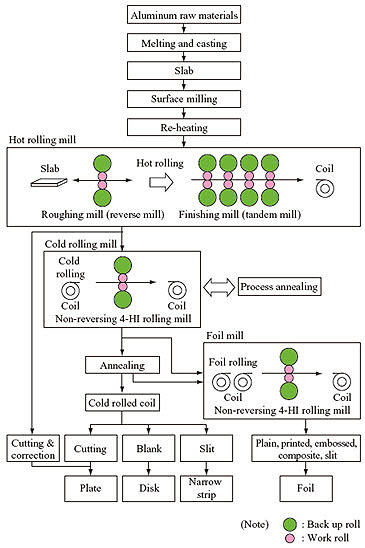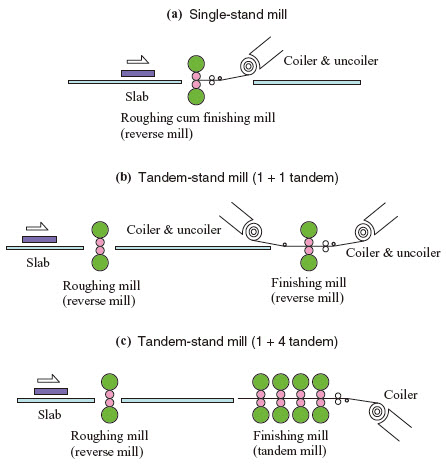Recent technological advancement in aerospace, automotive, marine, construction and leisure industries has made the demand for materials having high strength to weight ratio, high specific modulus, good corrosion resistance and good thermal conductivity to be on the increase. Aluminum and its alloys offer such combination of tremendous properties.
The processing of aluminum alloys from casting to end product is associated with a large number of metallurgical phenomena. In order to further improve and optimize process routes and alloys, a thorough understanding of the thermo mechanical treatments by experimental observations and physically based modelling is necessary.
Rolling is a mechanical process involved in many metals processing operations. Rolled aluminum products are essential materials for our daily life. Thick products are used as structural members for rail cars and aircraft, and thin products are used as packaging materials such as aluminum cans and aluminum foils.
Rolled products, i.e. sheet, plate and foil constitute almost 50% of all aluminum alloys used. In North America the packaging industry consumes the majority of the sheet and foil for making beverage cans, foil containers and foil wrapping. Sheet is also used extensively in building for roofing and siding, in transport for airframes, road and rail vehicles, in marine applications, including offshore platforms, and superstructures and hulls of boats.
Also, while relatively little is currently used in the manufacture of high volume production automobiles, it is expected that the next decade will see sheet used for both space frames and body panels, a market that could easily match the 2 million tons now used for beverage cans. Plate is used for airframes, military vehicles and bridges, ships superstructures, cryogenic and chemical vessels and as tooling plate for the production of plastic products. Foil applications outside packaging include electrical equipment, insulation for buildings, lithographic plate and foil for heat exchangers.
Figure 1 presents the manufacturing processes of rolled aluminum products. Rolling equipment is roughly divided into three kinds; namely, hot rolling mills, cold rolling mills, and foil mills. Usually, rolling is performed by applying a load to the materials by forcing them vertically through a pair of work rolls. The work rolls are deformed by the high load during the rolling process. Consequently, the shapes of the rolled strips are distorted. In order to address this problem, one or more back up rolls are installed above and beneath each of the work rolls in order to curb the deformation.

The hot rolling operation is performed at the highest possible temperature to lower flow stress in order to reduce loads and to achieve high reductions. An upper temperature limit is imposed by the need for controlling recrystallization and precipitation, dependent on the alloy, as well as by the occurrence of pick-up. During conventional rolling, the coarse as cast structure changes to a deformed and recrystallized structure having a considerably finer grain size. Coarse primary precipitates are crushed and become distributed more evenly. Decreasing temperatures during rolling and an increase in vacancy concentration in the lattice due to deformation lead to a further precipitation of secondary phases.
With regards to microstructure, hot rolling can be seen as a succession of deformation and annealing steps. The most dominant metallurgical features are recrystallization and the development of preferred crystal orientations (texture). Both processes are interrelated and influenced by ongoing precipitation. Recrystallization is particularly determined by the alloy system and the processing conditions. In high purity aluminum, the grain boundary mobility is high and the material already shows rapid recrystallization during processing (dynamic recrystallization).
However, in customary industrial alloys, dynamic recrystallization may be observed only at extremely high temperatures, where the effect is mainly caused by local bulging of grain boundaries and not by nucleation and growth. For these materials, recrystallization typically takes place during inter-stand times or after rolling at elevated temperatures (post dynamic or static recrystallization). In commercially pure alloys such as AA1050, typically used for packaging foil or lithographic sheet, elements with low solubility, like Fe and Si, interact with grain boundaries and efficiently obstruct recrystallization when present as finely dispersed precipitates.
The presence of Mn and Cr causes the same effect unless the elements are already bound in coarse particles. Within the Al-Mg-Mn alloy system, used in considerable amounts for beverage cans or automotive components, recrystallization covers a broad range within the scope of industrial conditions and thus can be influenced to a large degree by the choice of rolling parameters. In industrial practice, the recrystallized structure can be obtained in a separate annealing treatment, but more sophisticated technologies utilize self-annealing on the coil from the rolling heat.
In a traditional hot mill, aluminum ingots are soaked in furnaces before they are brought to the Reversing or Break-Down Mill to be reduced to a long and slender strip. Once the strip is dramatically reduced, then it is passed on to the Finishing Mill, a series of rolls further down the same line, where it is further reduced to the final thickness before being coiled at the end of the process. A continuous rolling line casts a continuous thin slab, which progresses through a roughing mill, and then a finishing mill before being coiled, all in one, continuous process. A plate mill has one break down mill and a separate finishing mill. The plate is passes repeatedly under the same mill until the final thickness is obtained.
Figure 2 illustrates example configurations of aluminum hot rolling mills. The configuration of rolling mills varies depending on the intended amount of production. Singlestand mills are used for the production of wide variety products in small quantities, whereas tandem-stand mills are used for mass production. In recent years, a notably common practice has been to commence operation with single-stand mills in order to minimize initial investment and add rolling mills in line with rising demand to make the transition to tandem-stand mills.
Hot rolling mills for aluminum have roll coating problems, as aluminum powder sticking to the surface of the work rolls affects the surface quality of the rolled strips. Brush rolls and other special mechanisms are installed into aluminum rolling mills as countermeasures for such problems.





QR Code
